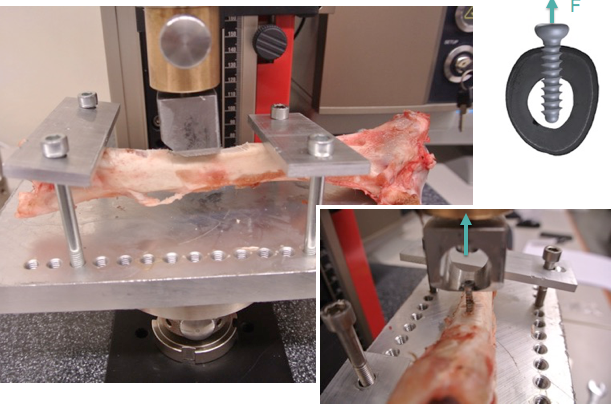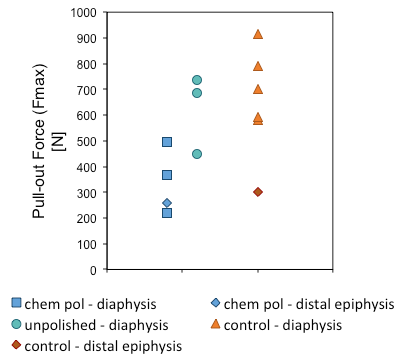Introduction: Magnesium (Mg) and its alloys possess ideal characteristics in mechanical properties and biological acceptance, and thus are of great promise for deployment as implant material, particularly in surgical stabilisation of bone fractures. The relatively fast degradation ability avoids second surgeries for removal of the implant [1]. Essential for their applicability is a sufficient load baring capacity for a clinically relevant time frame, which is directly linked to a reliable degradation rate and good bone ingrowth. , The purpose of this study was therefore to (1) analyse the general applicability of Mg-based screws for their use in cortical bone (2) study whether an improved degradation and therefore biomechanical performance can be achieved by chemical surface treatment.
Methods: Screws (diameter: 3.5 mm, length: 16 mm) were dry-machined from the biodegradable Mg alloy ultrahigh-purity (XHP) ZX00 (Mg-0.3Zn-0.4Ca). The surface of 4 screws was chemically polished (mixture of ethanol and phosphoric acid), whereas the others remained untreated. Seven screws (4 chemically polished and 3 unpolished) were gamma-sterilized and inserted into two ovine right tibiae (experimental, N=2 animals), and six further screws were implanted in the cadaveric right tibiae (control, N=2) after sacrificing the animal six weeks after implantation. These control screws were placed exactly on contralateral positions.
All animal studies were performed in accordance with the Austrian Ministry of Science and Research (accreditation number BMWFW-66.010/0190-WF/V/3b/2014). An axial pull-out test was performed on the screws of the in vivo groups, and the same method was also applied on the cadaveric control bones.

Fig. 1: Pull-out test method performed on XHP-ZX00 screws in sheep tibiae.
Results: The pull-out tests revealed lower strength of screws that stayed in the tibia for 6 weeks in comparison to the control group (Fig. 1). Chemically polished screws exhibited lower pull-out strength than untreated samples (sample size not sufficient for statistical comparison). [MC1] Analysis of bone cross section after pull-out tests revealed that the screws of both groups partly failed by shearing-off the thread flanks and partly by failure of the bone tissue.

Fig. 2: Pull-out test of XHP ZX00 screws (chemically polished and untreated) inserted in ovine tibiae (diaphysis and distal epiphysis) for 6 weeks vs. ex vivo control group.
Discussions and Conclusions: These first experiments show that screws made of XHP-Mg-alloy ZX00 revealed good bone integration. For all screws tested, after 6 weeks of implantation the pull-out test reveals lower load-bearing capacity in comparison to the non-degraded control. This loss in strength is associated with initial degradation of the screws and according to expectations. The lower pull-out strength of chemically polished screws may be due to volume loss resulting from the chemical surface treatment. Facing the importance of surface finish for medical implants, results emphasize the need of (1) careful adjustment of the polishing protocol and (2) thorough evaluation of its in vivo response. The interface strength still appears to be sufficient for clinical applications. Obtained data is subject of high volatility. Thus, further studies need to be performed to evaluate degradation, ingrowth and tissue reactions of Mg-screws in more detail.
Laura Bassi BRIC, Austrian Promotion Agency
References:
[1] K. Pichler, T. Kraus, E. Martinelli, et al (2014) Int Orthop. 38(4):881-9.